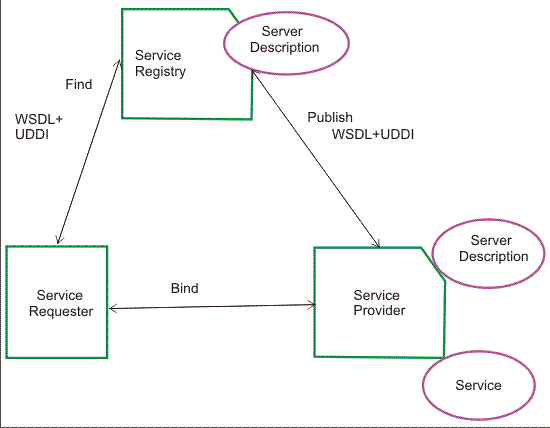| Previous | Home | Next |
Introduction
- WSDL is an XML based protocol and a language that UDDI uses.
- WSDL developed jointly by Microsoft and IBM.
- WSDL describes that what operations will performed when client accessing web service.
- It exchanges the information in decentralized environment
- It exchanges the information in distributed environment
- It used as a combination with SOAP and XML Schema to provide web services over the Internet

<definitions>
<types>
definition of types........
</types>
<message>
definition of a message....
</message>
<portType>
<operation>
definition of a operation..
</operation>
</portType>
<binding>
definition of a binding....
</binding>
<service>
definition of a service....
</service>
</definitions>
- Types
- Operations
- Binding
- Definition
- Types
- Message
- Input, describe parameter of web services.
- Output, describe return data of web services.
- Port type
- Binding
- Port
- The name attribute: It provide unique name among all port.
- The binding attribute: The binding attribute banded the linking rules that defined by the WSDL.
- Service
<definition> element is define the name of web service, it is la root element for any web services. It declares the namespaces. It is like a container for the other elements of the document.
<definitions name="ServiceName.." targetNamespace="..." xmlns=".." xmlns:soap="..." xmlns:tns="..." xmlns:xsd="..."> ........................... </definitions>
Every application needed to define its inputs and outputs in and out of there domain for that one element necessary to care of defining data types. In case of web services WSDL <types> element take responsibility to defining data types. The types are XML documents, or document parts. WSDL allowed the types to defined in separate elements in the document that provide benefit to use this types are with multiple Web services.
<types>
<schema targetNamespace=""
xmlns="">
<element name="Request">
<complexType><all>
<element name="request1" type="string"/>
</all></complexType>
</element>
</schema>
</types>
Between the Web service providers and consumers the data being exchanged described by <message>element. Each Web Service has two messages:
<message name="sss">
<part name="sss1" type=".."/>
</message>
<message name="rrr">
<part name="ggg" type=""/>
</message>
For each parameter of the Web Service's function defined it may be zero or for more <part>parameter. For all associates with a concrete type defined in the <types> container element.
The <portType> element combines multiple message elements and mapped to multiple transports through various bindings. We can say that a it provide a complete one way or round-trip operation. A <portType> can combine one request and one response message into a single request/response operation. The <portType> element commonly used in SOAP services.
<message name="sss">
<part name="sss1" type=".."/>
</message>
<message name="rrr">
<part name="ggg" type=""/>
</message>
HTTP GET, HTTP POST, or SOAP and other transport make binding easily available. The <binding> element provide that how the portType operation transmitted over the network. It provide concrete information about the protocols that is used for the transaction. Binding also provide information that where service uploaded.
<binding name="" type="">
A <port> element defines an individual endpoint by specifying a single address for a binding. Port be the restricted to specify more than one address information. It must be binding the address information. The port element has two attributes
The<service>element defined the ports and is a collection of port which supported by the Web service. There is only one port element for each protocol which supported the web services. It include the documentation element that provide the Human readable Documentation.
<service name="Name">
<documentation>Hello</documentation>
<port binding="" name="">
<soap:address
location="">
</port>
</service>
In addition to these major elements, the WSDL specification also defines the following utility elements:
Documentation: This element is used to provide Human readable document
Import: Its import the WSDL document.
| Previous | Home | Next |